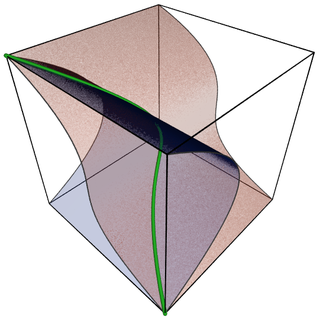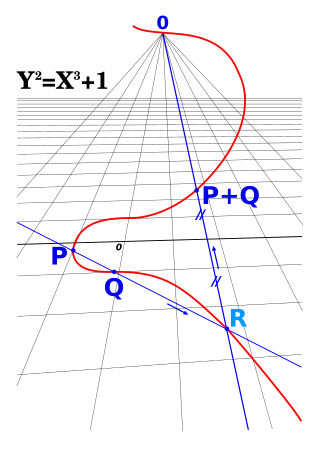
In mathematics, particularly in complex analysis, a Riemann surface is a one-dimensional complex manifold.
In mathematics, complex geometry is the study of geometric structures and constructions arising out of, or described by, the complex numbers. In particular, complex geometry is concerned with the study of spaces such as complex manifolds and complex algebraic varieties, functions of several complex variables, and holomorphic constructions such as holomorphic vector bundles and coherent sheaves. Application of transcendental methods to algebraic geometry falls in this category, together with more geometric aspects of complex analysis.

In mathematics, particularly in algebraic geometry, complex analysis and algebraic number theory, an abelian variety is a projective algebraic variety that is also an algebraic group, i.e., has a group law that can be defined by regular functions. Abelian varieties are at the same time among the most studied objects in algebraic geometry and indispensable tools for much research on other topics in algebraic geometry and number theory.

Algebraic varieties are the central objects of study in algebraic geometry, a sub-field of mathematics. Classically, an algebraic variety is defined as the set of solutions of a system of polynomial equations over the real or complex numbers. Modern definitions generalize this concept in several different ways, while attempting to preserve the geometric intuition behind the original definition.

In algebraic geometry, a projective variety over an algebraically closed field k is a subset of some projective n-space over k that is the zero-locus of some finite family of homogeneous polynomials of n + 1 variables with coefficients in k, that generate a prime ideal, the defining ideal of the variety. Equivalently, an algebraic variety is projective if it can be embedded as a Zariski closed subvariety of .
In mathematics, in particular algebraic geometry, a moduli space is a geometric space whose points represent algebro-geometric objects of some fixed kind, or isomorphism classes of such objects. Such spaces frequently arise as solutions to classification problems: If one can show that a collection of interesting objects can be given the structure of a geometric space, then one can parametrize such objects by introducing coordinates on the resulting space. In this context, the term "modulus" is used synonymously with "parameter"; moduli spaces were first understood as spaces of parameters rather than as spaces of objects. A variant of moduli spaces is formal moduli. Bernhard Riemann first used the term "moduli" in 1857.
In mathematics, the Jacobian varietyJ(C) of a non-singular algebraic curve C of genus g is the moduli space of degree 0 line bundles. It is the connected component of the identity in the Picard group of C, hence an abelian variety.

In mathematics, a complex analytic K3 surface is a compact connected complex manifold of dimension 2 with а trivial canonical bundle and irregularity zero. An (algebraic) K3 surface over any field means a smooth proper geometrically connected algebraic surface that satisfies the same conditions. In the Enriques–Kodaira classification of surfaces, K3 surfaces form one of the four classes of minimal surfaces of Kodaira dimension zero. A simple example is the Fermat quartic surface
In mathematics, deformation theory is the study of infinitesimal conditions associated with varying a solution P of a problem to slightly different solutions Pε, where ε is a small number, or a vector of small quantities. The infinitesimal conditions are the result of applying the approach of differential calculus to solving a problem with constraints. The name is an analogy to non-rigid structures that deform slightly to accommodate external forces.
In algebraic geometry, a moduli space of (algebraic) curves is a geometric space whose points represent isomorphism classes of algebraic curves. It is thus a special case of a moduli space. Depending on the restrictions applied to the classes of algebraic curves considered, the corresponding moduli problem and the moduli space is different. One also distinguishes between fine and coarse moduli spaces for the same moduli problem.

In mathematics, a complex torus is a particular kind of complex manifold M whose underlying smooth manifold is a torus in the usual sense. Here N must be the even number 2n, where n is the complex dimension of M.
In mathematics, a theta characteristic of a non-singular algebraic curve C is a divisor class Θ such that 2Θ is the canonical class. In terms of holomorphic line bundles L on a connected compact Riemann surface, it is therefore L such that L2 is the canonical bundle, here also equivalently the holomorphic cotangent bundle. In terms of algebraic geometry, the equivalent definition is as an invertible sheaf, which squares to the sheaf of differentials of the first kind. Theta characteristics were introduced by Rosenhain (1851)
In mathematics, the Abel–Jacobi map is a construction of algebraic geometry which relates an algebraic curve to its Jacobian variety. In Riemannian geometry, it is a more general construction mapping a manifold to its Jacobi torus. The name derives from the theorem of Abel and Jacobi that two effective divisors are linearly equivalent if and only if they are indistinguishable under the Abel–Jacobi map.
This is a timeline of the theory of abelian varieties in algebraic geometry, including elliptic curves.
This is a glossary of algebraic geometry.
In algebraic geometry and differential geometry, the nonabelian Hodge correspondence or Corlette–Simpson correspondence is a correspondence between Higgs bundles and representations of the fundamental group of a smooth, projective complex algebraic variety, or a compact Kähler manifold.

Klaus Hulek is a German mathematician, known for his work in algebraic geometry and in particular, his work on moduli spaces.
In mathematics, the moduli stack of elliptic curves, denoted as or , is an algebraic stack over classifying elliptic curves. Note that it is a special case of the moduli stack of algebraic curves . In particular its points with values in some field correspond to elliptic curves over the field, and more generally morphisms from a scheme to it correspond to elliptic curves over . The construction of this space spans over a century because of the various generalizations of elliptic curves as the field has developed. All of these generalizations are contained in .
In algebraic geometry, convexity is a restrictive technical condition for algebraic varieties originally introduced to analyze Kontsevich moduli spaces in quantum cohomology. These moduli spaces are smooth orbifolds whenever the target space is convex. A variety is called convex if the pullback of the tangent bundle to a stable rational curve has globally generated sections. Geometrically this implies the curve is free to move around infinitesimally without any obstruction. Convexity is generally phrased as the technical condition
Abelian varieties are a natural generalization of elliptic curves, including algebraic tori in higher dimensions. Just as elliptic curves have a natural moduli space over characteristic 0 constructed as a quotient of the upper-half plane by the action of , there is an analogous construction for abelian varieties using the Siegel upper half-space and the symplectic group .























